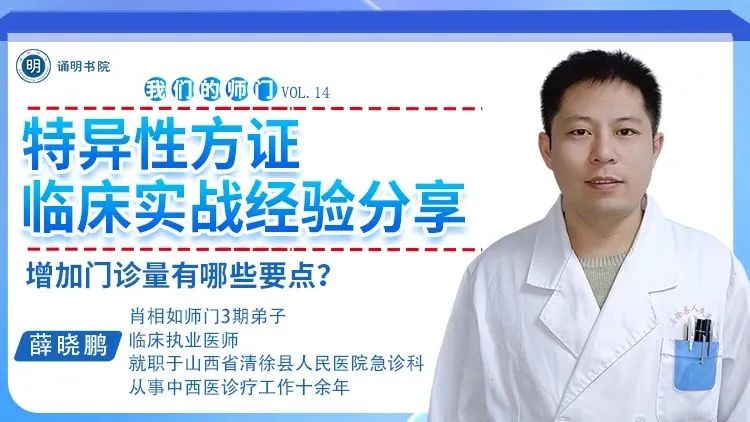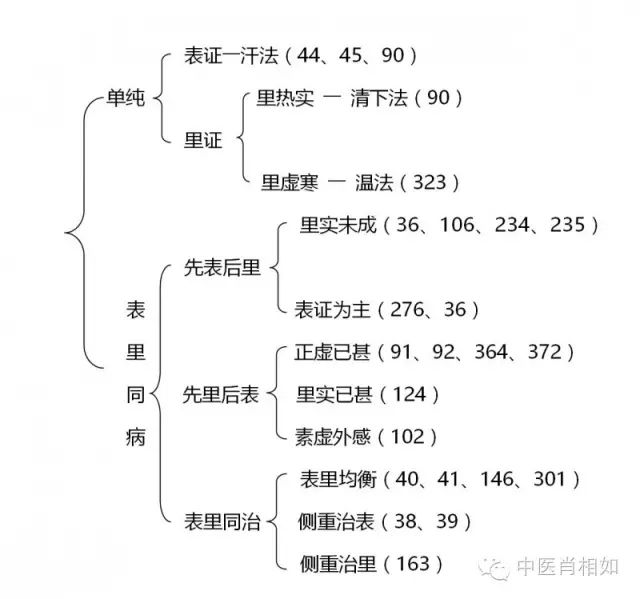Author: Xiao Xiangru, author of “Xiao Xiangru on Treating Kidney Diseases”, “Specific Formula Patterns”, “Lectures on Shang Han Lun by Xiao Xiangru”, “Reconstruction of the Diagnosis and Treatment System for Early Exogenous Diseases”, “Compilation of Treatment Methods for Impotence”, etc. Please cite the source.
Xiao Xiangru’s disciple Xue Xiaopeng will share live tonightClick the image to make an appointment to watch↓↓↓

< Main Text >
Zhang Zhongjing proposed a principle in the “Shang Han Lun” to prevent misdiagnosis and mismanagement of exogenous diseases, namely the principle of prioritizing the exterior or interior based on urgency. Unfortunately, this principle has not been given due attention, leading to frequent occurrences of misdiagnosis and mismanagement.
1
Treatment Principles for Exogenous Diseases
In the process of exogenous diseases, there can be simple exterior syndromes, such as the Ma Huang Tang (Ephedra Decoction) syndrome; or simple interior syndromes, such as the Bai Hu Tang (White Tiger Decoction) syndrome.
Of course, there are also mixed syndromes. For example, the Ma Huang Fu Zi Xi Xin Tang (Ephedra, Aconite, and Asarum Decoction) syndrome is an exterior syndrome combined with kidney yang deficiency; the Gui Zhi Ren Shen Tang (Cinnamon Twig and Ginseng Decoction) syndrome is an exterior syndrome combined with spleen yang deficiency; the Da Qing Long Tang (Major Blue Dragon Decoction) syndrome is an exterior syndrome combined with interior heat syndrome; and the Xiao Qing Long Tang (Minor Blue Dragon Decoction) syndrome is an exterior syndrome combined with water retention syndrome, etc.
Treatment of simple exterior and interior syndromes is relatively straightforward, while treatment of mixed exterior and interior syndromes is much more complex, but the basic principles remain consistent.
When the exterior syndrome is predominant and the interior syndrome is not urgent or severe, treat the exterior first;
When the exterior syndrome is not severe but the interior syndrome is urgent and severe, treat the interior first;
When the exterior and interior are relatively balanced, both can be treated simultaneously, and can be further subdivided into focusing on treating the exterior, focusing on treating the interior, or treating both equally.
In the process of exogenous diseases, failure to grasp the principle of prioritizing the exterior or interior based on urgency, or not adhering to this principle, is the root cause of mismanagement; and this has led to many heretical theories, such as wind-heat exterior syndrome, spicy-cool exterior resolving, having an exterior syndrome without an exterior pathogen, etc.
2
Treatment Example of Exterior Syndrome with Interior Heat
It must be emphasized that during the process of exogenous diseases, exterior syndrome combined with interior heat is very common. At this time, it is essential to firmly adhere to the principle of prioritizing the exterior or interior based on urgency; otherwise, mismanagement is inevitable.
For example, the Da Qing Long Tang syndrome occurs when there is a Taiyang (Greater Yang) cold damage with restlessness, meaning that alongside chills, fever, no sweating, and body aches with a floating and tight pulse, there is also restlessness, which belongs to the same disease of exterior and interior, with the exterior syndrome being predominant and the interior heat not severe, thus the principle of simultaneous treatment of exterior and interior should be followed, focusing on resolving the exterior while also clearing the interior heat.
Using Ma Huang Tang with increased Ma Huang to resolve the exterior and induce sweating to dispel cold, along with a small amount of Shi Gao (Gypsum) to clear interior heat, can lead to sweating and resolution of the illness.
If due to the patient’s restlessness and heat signs one hesitates to use Da Qing Long Tang, it can quickly transform into the Ma Xing Shi Gan Tang syndrome, which is frequently seen in clinical practice. Many pneumonia patients initially present with Ma Huang Tang syndrome, and due to fear of using Ma Huang Tang, they transform into Da Qing Long Tang syndrome, and if they still hesitate to use Da Qing Long Tang, they can transform into Ma Xing Gan Shi Tang syndrome.
In this case, Ma Huang Tang syndrome is a cold, while Ma Xing Gan Shi Tang syndrome has become pneumonia, which is a case of mismanagement.
3
Treatment Example of Prioritizing Interior Treatment in Same Disease of Exterior and Interior
There are also cases of same disease of exterior and interior that must treat the interior and cannot resolve the exterior.
Some patients with purulent infections may present with chills, even shivering, but in essence, they still have an exterior syndrome combined with interior heat; however, the interior heat has become severe and urgent, and at this time, the principle of treating the interior first should be followed, clearing the interior heat first. If one is constrained by chills and hesitates to clear heat, the condition will worsen.
In the study of warm diseases, there is a type of onset called “spring warmth”, where a cold pathogen received in winter does not manifest immediately, but instead hides within the body, transforming into heat. In spring, when exposed to a cold pathogen, the new cold pathogen triggers the hidden heat pathogen within the body, leading to illness. The clinical manifestation is that while there is severe interior heat and symptoms of blood and nutrient level involvement, chills and other exterior symptoms can also be observed. At this time, treatment must directly clear the interior heat and not resolve the exterior; resolving the exterior will exacerbate the interior heat.
Hemorrhagic fever can also present this way, with fever and widespread bleeding of skin and mucous membranes alongside chills. If one resolves the exterior at this time, the condition will worsen, quickly leading to low blood pressure shock and acute renal failure with oliguria, and in the absence of dialysis treatment, it can easily lead to multiple organ failure, such as congestive heart failure, pulmonary edema, cerebral edema, and ultimately death.
In 1981, when I just started working, I was assigned to the health center in Maozui Commune, Mianyang County, Hubei Province. I happened to encounter a major outbreak of hemorrhagic fever in Hubei, with dozens of hemorrhagic fever patients seen daily in the outpatient department and dozens hospitalized.
Initially, all hemorrhagic fever patients presented with fever and chills, so exterior resolving methods were used. However, after using exterior resolving methods, the condition worsened. It was later understood that hemorrhagic fever presents with fever and chills alongside bleeding, which is a blood level syndrome of warm diseases, and should follow Ye Tianshi’s principle of “entering the blood means fearing blood loss and movement, and must directly cool the blood and disperse the blood”, thus switching to using Xi Jiao Di Huang Tang (Rhinoceros Horn and Rehmannia Decoction) as the main treatment, along with heat-clearing and detoxifying herbs, which made the condition much easier to control, and clinical outcomes improved significantly.
The same disease of exterior and interior is a common clinical issue, and the treatment principles of prioritizing the exterior and interior based on urgency in the “Shang Han Lun” are extremely important. When encountering the same disease of exterior and interior, failure to correctly apply the treatment principles of prioritizing the exterior and interior based on urgency can lead to mismanagement and even more severe consequences. Everyone must treat this with caution!
4
Summary of Treatment Methods for Prioritizing Exterior and Interior in the “Shang Han Lun”

ENDNote: The numbered sequence represents the original text numbers from the “Shang Han Lun”. All learning enthusiasts are encouraged to read the “Shang Han Lun” carefully!Specific medication should follow medical advice..Previous Recommendations: Questions I have encountered in treating exogenous diseases, have you also faced them?
What is the concept of exogenous diseases, and how can we avoid confusion for those learning TCM?
What does “half exterior, half interior” mean? Have you stumbled upon these “pits” in the “Shang Han Lun”?
If you find this useful, please give a “like” before you go~~

